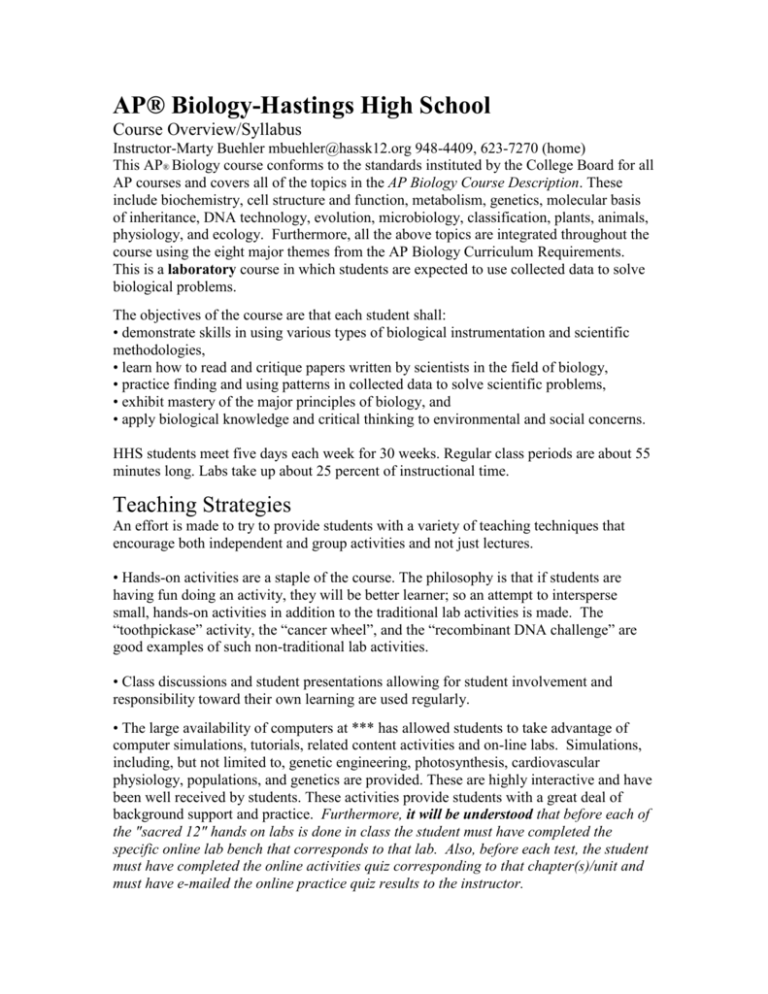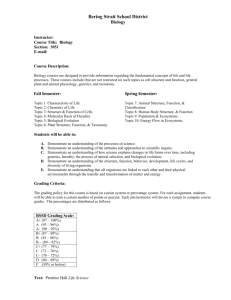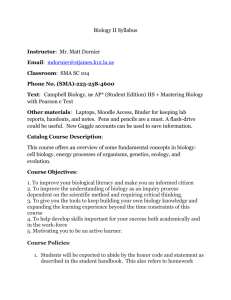Course Overview/Syllabus
advertisement

AP® Biology-Hastings High School Course Overview/Syllabus Instructor-Marty Buehler mbuehler@hassk12.org 948-4409, 623-7270 (home) This AP® Biology course conforms to the standards instituted by the College Board for all AP courses and covers all of the topics in the AP Biology Course Description. These include biochemistry, cell structure and function, metabolism, genetics, molecular basis of inheritance, DNA technology, evolution, microbiology, classification, plants, animals, physiology, and ecology. Furthermore, all the above topics are integrated throughout the course using the eight major themes from the AP Biology Curriculum Requirements. This is a laboratory course in which students are expected to use collected data to solve biological problems. The objectives of the course are that each student shall: • demonstrate skills in using various types of biological instrumentation and scientific methodologies, • learn how to read and critique papers written by scientists in the field of biology, • practice finding and using patterns in collected data to solve scientific problems, • exhibit mastery of the major principles of biology, and • apply biological knowledge and critical thinking to environmental and social concerns. HHS students meet five days each week for 30 weeks. Regular class periods are about 55 minutes long. Labs take up about 25 percent of instructional time. Teaching Strategies An effort is made to try to provide students with a variety of teaching techniques that encourage both independent and group activities and not just lectures. • Hands-on activities are a staple of the course. The philosophy is that if students are having fun doing an activity, they will be better learner; so an attempt to intersperse small, hands-on activities in addition to the traditional lab activities is made. The “toothpickase” activity, the “cancer wheel”, and the “recombinant DNA challenge” are good examples of such non-traditional lab activities. • Class discussions and student presentations allowing for student involvement and responsibility toward their own learning are used regularly. • The large availability of computers at *** has allowed students to take advantage of computer simulations, tutorials, related content activities and on-line labs. Simulations, including, but not limited to, genetic engineering, photosynthesis, cardiovascular physiology, populations, and genetics are provided. These are highly interactive and have been well received by students. These activities provide students with a great deal of background support and practice. Furthermore, it will be understood that before each of the "sacred 12" hands on labs is done in class the student must have completed the specific online lab bench that corresponds to that lab. Also, before each test, the student must have completed the online activities quiz corresponding to that chapter(s)/unit and must have e-mailed the online practice quiz results to the instructor. Text Campbell, Neil A., J. Reece, and L. Mitchell. Biology, 5th edition (1999) Approximate Course Planner Introduction to lab work, investigations, and write up stylePillbug and termite lab. (Animal behavior, lab 11): First week of class. Molecules and Cells Molecular Biology (3 weeks) • Water • Organic molecules: Testing reagents for biomolecules lab • Enzymes: General properties of enzyme activity and toothpickase. • AP Lab 2: “Enzyme Catalysis” Cell Biology (3 weeks) • Review cell structure from pre-AP course • Cell membranes and transport mechanisms. • AP Lab 1: “Diffusion and Osmosis” • Cell organelles: Structure and function Energy Transformation Photosynthesis (1 week) • AP Lab 4: “Plant Pigments and Photosynthesis” • Photophosphorylation and chemiosmosis • Photosynthesis adaptations (CAM, C4) Respiration (1 week) AP Lab 5 •Respiration lab from Computers for Biology with Vernier and computers Respiration vs. Chemosynthesis, pollution/ecology. The Global Perspective – The Inconvenient Truth. (2 days) Ethical discussions, science and society. Cell Division and Genetics Cell Division (1 week) • Introduction to chromosomes and their anatomy, desk mitosis student demos. • AP Lab 3: “Mitosis and Meiosis” • Cell factors affecting genetic variation • Crossover ratio activity with Sordaria • Mendelian genetics (1.5 weeks) • Mendelian principles with applications to monohybrid and dihybrid crosses • AP Lab 7: “Genetics of Organisms” • Computer simulation: Mendalians Human Genetics (1.5 weeks) • Mutational change at the chromosome and molecular levels • Genetic conditions affecting humans, student research reports on one condition. • Karyotype analysis activity Molecular Genetics (5 weeks) • Introduction to the structure of DNA and RNA • DNA isolation activity: Spooling from onion cells • Regulation and function of genes. • Genetic engineering. • Advances in genetic technology: RFLP analysis, etc. Paper/pencil simulations and activities about recombinant DNA technology and applications (like the paper plasmid challenge), AP Lab 6: “Molecular Biology” “GATTACA”-Ethical considerations of science and society, discussions/debate… Evolution (2.5 weeks) • Evidence of evolution • Mechanisms of evolution: AP Lab 8: “Population Genetics and Evolution,” Speciation on-line activities. Thought problems dealing with geographical isolation scenarios. Original peppered moth papers and it’s historical development. Embryological Development. (2 days) Comparative Life Cycles. (3 days) Comparative plant reproduction: algae, ferns, mosses, conifers, angiosperms [C3] Plants: Transpiration and AP Lab (4 days) water potential, movement in plants. Hormonal influence on plant growth. Structure and Function of Systems: Homeostasis Stress and the Circulatory System (1week) • The role of blood in the body • The immune response • Blood pressure: AP Lab 10: “Physiology of the Circulatory System” • ECG: Vernier biology with computers Nervous System (1 week) • Sensory input: A lab looking at aspects of vision—tunnel vision, peripheral vision, color vision, depth perception • The role of the brain in analyzing input The Endocrine system (3 days) Homeostatic Mechanisms of the Excretory System (1 week) • The kidney and homeostasis • Kidney dialysis (diffusion and osmosis are reviewed here) Reproduction (1week) Changes in the female body prior to and following fertilization. Embryological development: stages of frog and chick development. Comparative Anatomy and Physiology of systems from various Animal Kingdom Phyla to Vertebrates. (2 days) Animal Behavior revisited. (2 days) Extra Possible Activities Activities above and beyond the AP curriculum include field trips such as a trip to Chicago (for work at Brookfield Zoo with a geneticist and animal behavior specialist among other things). Also, independent study groups are brokered. Science Olympiad events are assigned to some AP kids. Hope college science day is planned for too. Grading: Grading will be determined on a percentage based on an average of all assignments, labs, tests, and quizzes with a grading scale of 100-90% = A (+’s and –‘s added as usual), 89-80% = B, 79-70% = C, etc. Grading Breakdown for AP Biology final grades….. 30% Labs (Formal and “Relaxed”) 50% Tests and Quizzes 20% Miscellaneous (homework, computer work, etc.) Weighting of grades will occur at the semester on semester totals only. Assessments: Announced tests will be given at least every 2-3 weeks, but probably more often. Most tests will be designed to simulate the Boards in appearance and content. Commonly, students will be required to do “Free-response” questions as well as multiple-choice questions. Laboratories: will be followed by student write-ups/reports. Some will be required as “Formal” and will need to be assembled using a very specific format (see attached). Late labs will not be accepted after one week. Lab work should be kept in a 3-ring binder to simulate journals/lab notes kept by scientists. Make-Up Work: will be allowed 2 days for each day absent for full credit, but any work turned in late past that (or otherwise late) will be assessed a 10% a day penalty. Remember, labs only can go late up to one week though. Laboratory Formal Write-Up Format: Keep your own notebook to defend your work. I. Sections. ______4% a. Title: Catchy, but not sensationalized (not to “cute”), detailed, descriptive, informative. “Lab 11 Animal Behavior” is bad and unacceptable. ______10% b. Abstract: This should be a summary or review. Read some scientific journals for examples. ______11% c. Introduction/Purpose: Pose the question. Include the Hypothesis here too. Make sure the hypothesis is in classical Hypothetico-deductive style. (see Text). ______10% d. Experiment/Procedure; Watch your controls! Handle your variables correctly! Reference the directions, if that is exactly what you did, otherwise you need to include any deviations or unique procedures that you performed. ______11% e. Data/Results: Just state them, don’t discuss. Label everything well. Graph technique and attention to graphing requirements and their detail is huge here. Don’t try to fudge bad data here. I know the data before you do. Don’t think you can fool me. You will get caught. ______11% f. Conclusions and Discussions: Address your purpose. Be Thorough. Discuss the controls again and how it allows you to make conclusive statements. Start your “sources of error” discussions here. ______3% whatever. g. Works Cited: Any books you need to reference. Lab book, texts, General Requirements: 1. 2. 3. 4. 5. 6. 7. Write in third person-always. (passive voice) Include headings for each section a-g above. Any work cited ( interviews, text-work, etc) should follow the author date system. Figures are numbered and included at the end of the paper. Length of the paper should not exceed eight typed DS pages. So yes, type them. Tables are numerized and included within the body or at the end of the paper. Graphs are full page, scaled and labeled appropriately, and “lined” correctly. Lab format and format scoring continued….. Lab Logic Sections II. Sound Analysis: ______20% I look to see if your purpose is on track, if your conclusion makes sense, if it matches the purpose, if your discussions are good and logical, and if you have displayed a good amount of thought as you considered every aspect of this lab. III. Justifiable Conclusions: ______20% Do you include any statistical evaluations or analysis techniques (% accuracy, hardy-weinburg, mean, deviation, whatever) in your conclusions? Do you use logic to back up your statements in your conclusions? Can I shoot your answers, data, conclusions, set-up and control usage (scientific method), full of holes or does it stand up to scrutiny? If not, at least attempt to suggest ways to fix it next time! IV. Peer reviews: If it is a peer grading day then you may grade another students paper using the rubric I supply for an additional +5% extra credit. It must be done thoughtfully and thoroughly as I check them too. (We do this to allow you to see different styles) Note: on occasion, this is done in free response grading as well. Final Summary of Course Content: In review, the course content will involve the following categories, approximate emphasis and cover Eight major themes. They are: Content: approx. % of Boards a. Molecules and Cells (includes Chemistry of Life, Cells, Cellular Energetics, etc.) 25% b. Heredity, Genetic Eng., Evolution discussions 25% (includes inheritance patterns, Eukaryotic chromosomes, Meiosis, and gametogenesis, a lot of molecular genetics and mechanisms of evolution) c. Organisms and Populations 50% (includes Diversity of Organisms, Structure and function of plants and animals, Ecology) Some, like Ecology, will be on your own. MAJOR THEMES: I. Science as a Process II. Energy Transfer III. Continuity and Change IV. Evolution V. Relationship of Structure to Function VI. Regulation VII. Interdependence in Nature VIII. Science, Technology, and Society





